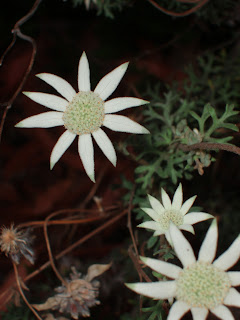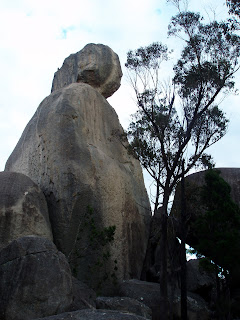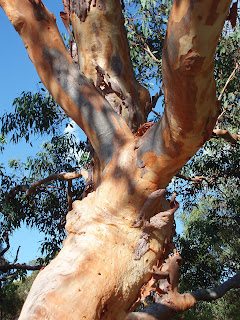Girraween National Park in the very south of Queensland’s Granite Belt is 11,800 hectares of rugged granite peeks, precariously balanced boulders, Eucalyptus forest and open sedge and heath land. The name ‘Girraween’ is Aboriginal for ‘place of flowers’, and is an apt name as there are said to be spectacular displays of wild flowers through out he spring. Now in March, late summer, the hot dry weather has seen an end to the main floral show. Though there has been higher than average rainfall and the many fallen trees and piles of grass, twigs ad branches heaped up against the rocks are testament to the floods that swept through the park earlier in the year, the heath land and forest floor is now dry.
One of the precariously balanced boulders silhouetted against the sun and a shadow on the granite face of the dominant feature of the park ‘The Pyramid’, a large granite dome rising high above the canopy of the surrounding Eucalyptus forest
One of the open areas of heath land and the exposed rocky summit of Mount Norman in the distance.
The thin coarse soil dries out fast in the heat but there were still a few tough flowers in bloom. The most prominent were the bright golden daisy flowers of Bracteantha bracteata (Golden Everlastings) a perennial herb growing in the open forested areas of the park. Also flowering among the open Eucalyptus forest the silver flowers of Actinotus helianthus (Flannel Flower). It is called the ‘Flannel Flower’ as the plant is entirely covered with soft woolly hairs, a likely adaptation to dry conditions. Creeping through the boulders on the higher slopes, the tiny yellow flowers a Goodenia species.
Bracteantha bracteata ASTERACEAE (top), Goodenia species GOODENIACEAE (bottom left) and Actinotus helianthus APIACEAE (bottom right).
It was a hot and particularly humid afternoon and by the time I’d hiked up the 45
o sheer granite face of the Pyramid rock I was suitably knackered. Cracks in the rock erode over time leaving behind balancing boulders, some stacked two or three high. The silhouetted rock at the top of this blog is a good five metres high and is perched on the summit of the pyramid; but for how much longer? The summit offers views over the forest canopy to the bulk of near by
Bald Rock to the East in New South Wales, the state line running between the two peeks. I sat for a while watching thunder clouds building on the horizon in the humid air. By the evening these had build into a large storm and produced some spectacular lightning for a good few hours.
Looking up to the summit of the Pyramid (left) and a tenacious black cypress clinging to a crack in the rock.
Several of the rock formations throughout the park have been given names such as ‘The Sphinx’ with a small stretch of the imagination does vaguely resemble its namesake. Others, like the rock formation named ‘The Turtle’ in my opinion may require a little something in addition to just your imagination to fully appreciate their form.
The Sphinx and building thunder clouds.
Twenty five species of Eucalyptus are present in the forest surrounding the pyramid and I’m afraid my Euc ident skills aren’t up to much and many are only distinct and identifiable when in flower. None of the trees were in flower but one of the species stood out from the others with bright amber/orange peeling bark glowing in the low, late afternoon light. A few trigger orchids were flowering among the leaf litter.
Trigger Orchid and Eucalyptus species.
A couple of empty cicada grub exoskeletons clinging to the underside of a tree.






































































































